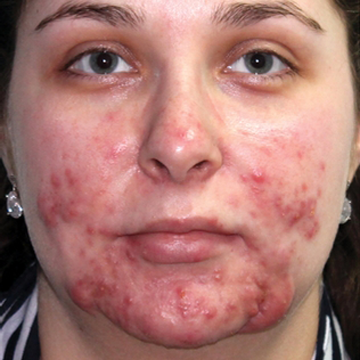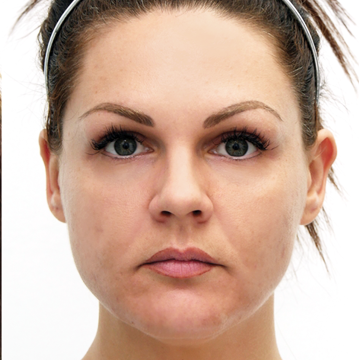Avant / Après






Acne rosacea is a chronic inflammatory disease that causes many difficulties for people who suffer from it. It most often affects light-skinned patients between the ages of 30 and 50, but it also appears on darker-skinned patients in whom it is likely to be under-diagnosed. It predominantly affects women and is usually located in the central region of the face: the nose, the cheeks and the forehead. Untreated acne rosacea can ultimately lead to persistent inflammation and skin distortion, known as "Brandy Nose". Therefore, it is important to keep this condition in check, as it cannot be totally cured.
While heredity may be a factor in the transmission of acne rosacea, certain factors are well identified as triggers of the disease such as alcohol, female hormones, sun exposure, sports, spicy food, stress, and temperature changes. Even if these factors are avoided, the progression of acne rosacea remains uncertain, and this is where we can intervene to help you.
Acne rosacea is a very distinct condition from juvenile acne. It can occur in several isolated or combined subtypes:
To contain and alleviate acne rosacea, it is possible to use topical or systemic (during exacerbations) antibiotics. Creams may also be prescribed. Intense pulsed light is a particularly interesting tool because it reduces inflammation and redness and helps to sterilize the skin.
Photorejuvenation with pulsed light is a tool that can be used to treat common skin problems. The Sciton medical platform is equipped with a BBL (BroadBand Light) that allows for the filtration of the light at the desired wavelength to target the desired problem, to safely treat a wide range of skin problems. Among these problems, hyperpigmentation brown spots (solar lentigos), age spots and also rosacea. In general, IPL will be used between one and four times a year. A series of treatments may be required when we start treating a severe case of acne rosacea.
It is important to note that the phymatous aspect of the nose or any other area can be treated with technology. It is now entirely possible for us to reduce the size of the nose and its hypertrophied appearance by using technologies such as Alma Laser's Accent Prime, and Ulthera. The PDO threads also have the ability to bring about a contraction and uniformity of the skin tissue.






Docteur Laflamme est pleine d'énergie positive, très sympathique et très professionnelle.

J'ai pris les traitements laser pour le bikini, et les résultats sont bien apparent et le personnel est très qualifié.

Superbe équipe toujours attentionnée envers le client, à l'écoute de nos besoins afin de proposer des traitements personnalisés.

Je recommande la clinique, propreté, excellent résultat en épilation laser. Le personnel est courtois et plusieurs services offerts.

Mes yeux WOW!! Nous avons trouvé la formule magique!Merci de nous permettre de profiter de vos multiples talents.
Clinique Laflamme offers you a free initial consultation when you subscribe to the newsletter in order to offer you personalized treatment.